You know what they say, ‘if you can’t stand the heat, get out of…’
So, on a sticky, sultry summer’s day we decided to do just that and headed out of the bustle of the sweltering City of Caves, looking for somewhere shady, cool and calm.
It began, as most of our trips do these days, with a bus journey. This one the Trent-Barton Indigo service to Derby which leaves about every ten minutes from the middle of Nottingham. What a shame it wasn’t this beauty.
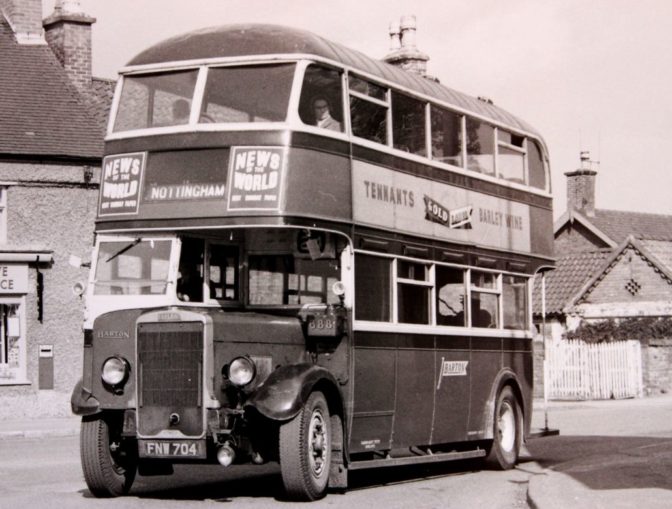
© Alan Farrow, licensed under CC PDM 1.0
I’ve probably mentioned once or twice that the public transport in this area is really good. Perfect when we (deliberately) no longer have a car, we can easily get to all sorts of interesting places with a day ticket, inexpensively too as my husband travels free after 09:30 with his ‘old git’ card. Our trips out are great fun, helping to keep us sane in this crazy ‘new-bloody-normal’ world.
This route, which we’ve followed on numerous occasions, is an interesting one even before it leaves Nottingham. It takes us out of the centre up to Canning Circus, a high gateway to the old town (Nottingham only became a city in 1897). At this point, six roads meet, and the junction is now marked by the alms houses to either side of the cemetery gatehouse, with its arched entrance and clock tower.
In earlier times, Mediæval travellers arriving after dark, too late to enter the town, would find their rest and other entertainments in the plethora of local inns around the junction before they made the final stage of the journey down the hill the next morning. But then as now, you could pass through without realising that there was a warren of caves beneath you.
Nottingham’s caves have been in use for over 1,000 years and are man-made, carved by hand out of the bunter sandstone for a variety of purposes. Some have been used as pubs or ale-houses, breweries or for malting grain, as bakeries, as stables, slaughterhouses, butchers and tanneries, for cock-fighting, as cess pits, middens and garderobes (Mediæval loos), as foundries, blacksmiths and cutlers, for candle-making and even bank vaults, a rifle range and dungeons.
A somewhat more recently cut one, close to Canning Circus, was commissioned as an ornamental garden feature around 1870 by an eccentric landowner, Alderman Thomas Herbert. His ‘Columns Cave’ was said to resemble an Egyptian temple, and included square rock columns with bas relief carvings of gods, goddesses, druids and crucifixes.
Although many caves were cut to use for housing (indeed one near Canning Circus was still occupied until 1924), numerous others were simply used as storage cellars due to their cool, constant temperatures.
Indeed, a ballad sung to the tune of ‘Lilly Burlero’ was written in the 1700s extolling the virtues of ‘Nottingham ale’. The brew’s excellence was renowned (er, apologies to our LP). In part, this fame and the superiority of the ale has been attributed to the cave cellars in which it was stored, and quite possibly brewed.
“Nottingham ale, boys, Nottingham ale,
No liquor on earth like Nottingham ale.
Ye bishops and deacons, priests, curates and vicars,
When once you have tasted, you’ll own it is true.
That Nottingham Ale, it’s the best of all liquors;
And who understands the good creature like you”
Some of the honours, however, may be explained by the quality of the water with its significant levels of gypsum, and the versatile Nottingham yeast which allows a variety of traditional styles to be brewed with a single yeast, including Pale Ale, Amber, Porter, Stout and Barleywine.
Moving onwards from the Circus and heading down Derby Road, we pass the old army drill hall and the site of Britain’s last small independent cigar-making factory, Edmund Alton & Co., whose ‘army of women’ hand-rolled high-quality Havana tobacco cigars for Harrods and Selfridges, and supposedly for Sir Winston Churchill.
The road bottoms out after descending a steep hill, taking us over the little River Leen, and through Lenton. Not much to look at these days except the general messiness of multi-occupancy student houses, but this was the home of the 12th century Cluniac monastery of Lenton Priory. The Norman-style Priory was a truly magnificent stone building, quite exceptional at a time when even the royal castle was constructed from wood and earth.
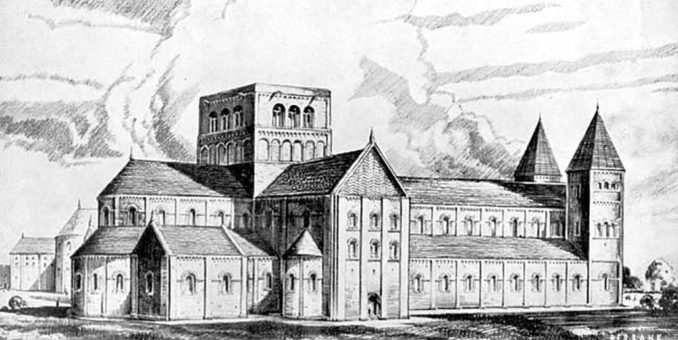
© A P Nicholson
It has been long been believed that Lenton Priory was almost completely demolished after the execution of Nicholas Heath, the last prior of Lenton, and his monks for high treason during the Dissolution of the monasteries. Indeed, little more than a pillar-base remains visible today in its original location—this can be found at the corner of Priory Street and Old Church Street. But a recent geophysical survey of the area suggests that much more remains of the structure of the main Priory church, albeit no longer visible above ground level.
We then travel on through Dunkirk, whose name means ‘the church on the hill’. It strikes me as an odd choice of name for a place only around 100 feet above sea level with significantly higher land to the northeast and northwest and an East Midlands Counties League football team with the nickname of “The Boatmen”.
The route continues along the southern border of University Park, the main campus of the University of Nottingham. It is a beautiful site, covering some 35 acres of land which was given to Nottingham’s Civic College by philanthropist Sir Jesse Boot (of Boot’s the Chemist fame) in 1928.
The campus seamlessly integrates with Highfields Park, a further 121 acres of public space, owned and maintained by the City Council. There’s a lot to it, with a wealth of wildlife (as well as students!), complete with woodlands, a crazy golf course, a boating lake, stepping-stones, and a little waterfall. In a sandstone outcrop there are caves here too, and I’m told, although closed off in these days of H&S rulebooks, these played host to some legendary student parties in days gone by.
Beeston is our next stop, a pleasant little town recorded in the 1086 Domesday Book as Bestune. It’s a former centre for silk-weaving and, briefly, one of the sites where Humber cars and bicycles were produced. It is also home to Boot’s HQ, where the non-steroidal anti-inflammatory drug Ibuprofen was synthesised by a research group led by Stewart Adams in 1961. Boot’s has long been a major employer in the region, but it’s just about to cut around 7% of its workforce (mostly from HQ), some 4,000 jobs lost because of the ‘Rona.
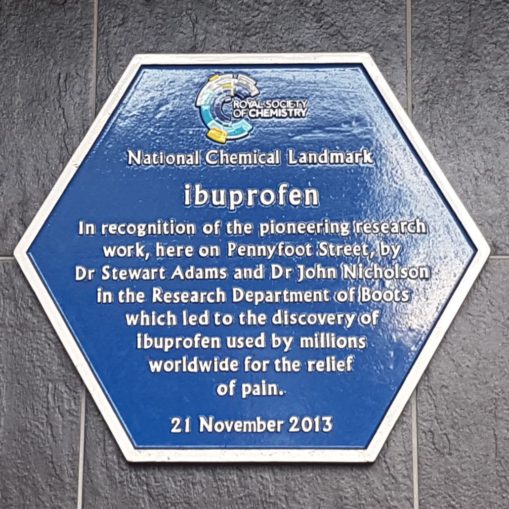
© SMacB, licensed under CC BY-SA 4.0
An interesting aside, Adams initially tested the drug to relieve a hangover. I wonder if he acquired that at The Star, a rather decent hostelry specialising in local-brewed beer?
The road carries on to Chilwell, again mentioned in the Domesday Book, but doubtless dating back to earlier times as Roman antiquities have been found there. It is, rather sadly, probably best known for the Chilwell Ordnance Factory explosion of 1918.
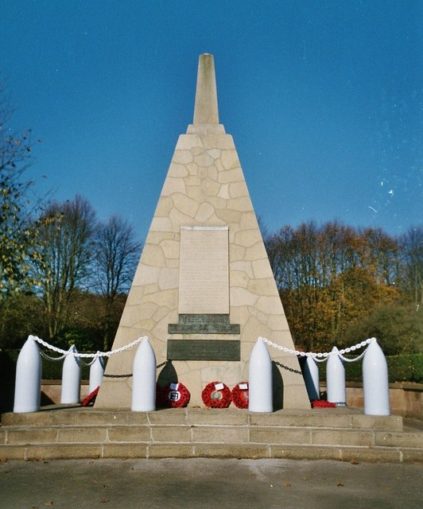
© Andy Jamieson, licensed under CC BY-SA 2.0
Some eight tons of TNT exploded at the National Shell Filling Factory No. 6, killing 134 workers, of whom only 32 could be identified. This was the biggest loss of life from a single explosion during World War One and, amazingly, it was kept secret at the time. The victims of this accident were mainly women, and were known as ‘munitionettes’ or, less kindly, as the ‘Chilwell Canaries’. This was because repeated exposure to the toxic trinitrotoluene (TNT) from their munitions work meant that their skin and hair turned an orange-yellow colour, similar to a canary’s feathers. Explosion aside, theirs was really not a healthy life.
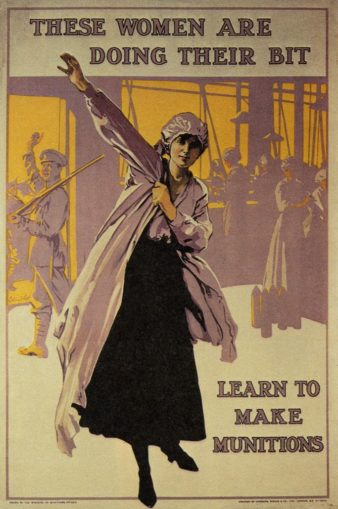
© MCAD Library, licensed under CC BY-SA 2.0
By the end of World War One, around 80% of the weaponry used by the British army was being made by women in factories such as Chilwell, and they paid dearly to ‘do their bit’. Not only were they typically paid less than half the wages of male colleagues, but their bodies reacted adversely to the toxic TNT.
Health problems generally started with a metallic taste in the mouth, then sneezing, a severe cough and sore throat. Significant digestive problems weren’t uncommon. Some women suffered from a weakened immune system, vomiting, hair loss, anaemia, or migraines. Other experienced breast deformation or fertility problems, and the yellowish colouration even affected any babies born to them. At the time, nothing could be done for the ‘Canary Babies’ and although, thankfully, the discolouration seemed to slowly fade given time, little is known about the long-term effects.
On a rather more pleasant note, Chilwell is also the gateway to the Nottinghamshire Wildlife Trust’s Attenborough Nature Reserve, nearly 360 acres of wetland, reclaimed from flooded gravel pits. Over 250 bird species have been recorded here, and it’s an important overwintering area for shoveler ducks (a.k.a. dabbling ducks) and diving ducks.
A fabulous place to walk, summer and winter, we have seen a variety of ducks, geese, grebes, woodpeckers, kingfishers, herons, egrets and smaller birds there, bats and butterflies too, but have yet to see the otters or, better yet, the bitterns. But Attenborough’s not for us today though, we’re heading for a canal walk, and a lovely stretch of water it is too.
Off the bus we hop at Long Eaton, a nice market town with an Art Nouveau style library, the Carnegie Library. Lace-making and the manufacture of railway wagons (both sadly gone) brought the town its wealth. At its height, there were nearly 1,400 lace machines in the town, with the industry employing around a quarter of the population.
Now, not much evidence of this is visible, except for some of the architecture. A massive red-brick lace mill, the distinctive four-storey Harrington Mills built in the 1880s by a consortium of lace-makers remains, although now the home to furniture manufacturers and the Harrington Mill Studios, which provides 18 affordable spaces for local artists. No stranger to art is Long Eaton, as one of Britain’s most renowned artists, Dame Laura Knight, hails from the town.
We’ve finally reached our starting point but, before we set off walking, we decide that a coffee and a home-made scone would be a good idea. Naughty indeed, but what the hell – so we head to a favourite café, ‘Copper Cogs’.
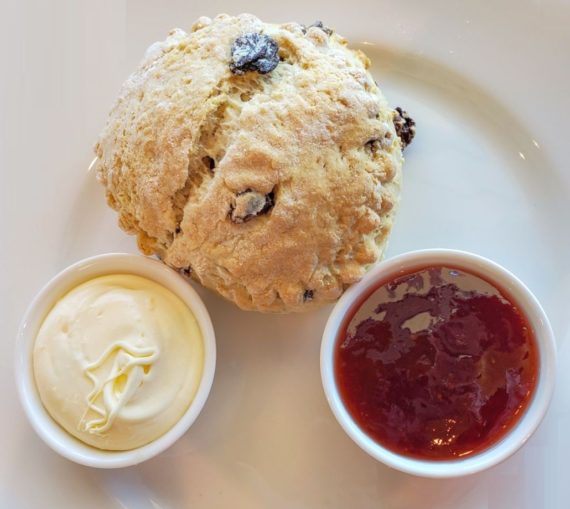
© HarshLight, licensed under CC BY 2.0
On the wall as you step inside the café are a few framed sheets of dirty and discoloured newspaper, discovered when the building was being renovated. The paper is ‘The Daily Sketch’, dated April 23, 1919, and one of the articles seems relevant even 100 years on—it reported that ‘515 people die from influenza in Sydney’. Plus ça change, plus c’est la même chose?
Both the coffee and scones (with clotted cream and jam) are delicious, and I’d like to say a big ‘thank you’ to all you lovely Puffins for contributing half the cost, however unwillingly, through fishy Rishi Snack’s ‘Eat Out to Help Out’ scheme!
However, while we’re enjoying our treat, we remember something we hadn’t thought about. The last time we walked this stretch of the Erewash Canal it was also a pretty warm day. The canal runs roughly north-south heading towards Sandiacre, parallel to the River Erewash for part of the way, and there’s precious little shade along the towpath.
Today is an even hotter day, and with the reflection off the water, we’re going to shallow-fry if we walk this stretch. Ooops, time for a rethink! Perhaps we should take the bus to Sandiacre, then walk along the canal towards Ilkeston? That would be a better bet, as the towpath there is tree-lined and should be shady.
Thankfully the bus service runs pretty frequently so that’s what we do, getting off next to the 150 year old Sandiacre Town Cricket Club’s ground which is just across the road from the Erewash Canal. Although the ground still looks beautifully cared for, sadly there’s no match on today.
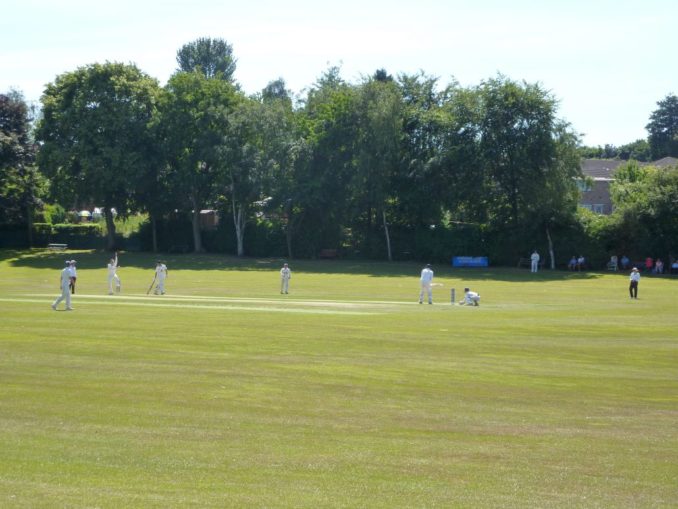
© SharpieType301 2018
It is so pretty here, and the Erewash Canal is home to a good variety of plants and wildlife, probably because it doesn’t see a great deal of boat traffic so is relatively undisturbed. It was built in 1779, mainly for transporting coal from the Erewash Valley, quarry stone, bricks and metal products, with its last commercial cargo delivered by narrowboat in 1952. It’s a little gem and, even though it is only 12 miles long, it was one of the most successful in Britain in its heyday.
In the peaceful surroundings of today’s canal, we enjoy the territorial antics of a couple of Brown Hawker dragonflies, challenging each other for hunting rights on ‘their’ stretch of water. They’re moving far too quickly to photograph, while the more peaceful Banded Demoiselle and Common Blue damselflies get on with life on the water’s edge, hovering on dainty wings above silvery shoals of tiny fry. There’s a wealth of plant life too, and with so many colours and textures reflected in the water it’s simply lovely.

© SharpieType301 2018 2020
By now the day has heated up considerably, so for once we are sensible and buy a couple of bottles of water, and sit by the waterside to enjoy them before we start walking. There’s barely a breeze and the expanding ripples from lazily rising fish are quickly spotted on the canal’s still surface. Mind you, for all this it’s not a quiet, peaceful location as we’re right next to a busy road junction and some massive lorries rumble across Derby Road bridge.
Still, the main advantage of this spot is that there are public loos, and they’re open! This is something we now remember to look out for. In these days of Covidiocy you can’t just pop into a local hostelry like you used to without first providing name, contact details, a genealogy chart comprising the last thirty generations of your ancestry and the inside leg measurement of Auntie Ida’s cat! OK, I might have made the last bit up, but who knows what they’ll bring in next.
Sandiacre was another lace-making town. One of the old mills, built for wealthy, hardworking industrialist Terah Hooley, the 1888 Springfield Mill with its distinctive tall chimney, stands on the edge of the canal right next to the towpath. This lovely Grade II listed building, which had 160 lace machines running in its heyday, was preserved by being converted into luxury apartments, but towards the end of April this year a major fire, caused accidentally, burned for hours and resulted in massive damage. At one point, 21 fire engines attended. Thankfully work is already underway to restore it to its former glory.

© SharpieType301 2018
Interestingly, Terah Hooley’s only son, Ernest Terah Hooley, was a somewhat shady, though apparently a very charismatic man. He is remembered as the developer of the world’s first industrial park, Trafford Park on the southern side of the Manchester Ship Canal, but his speciality was acquiring companies which he then resold to the public at inflated prices. Nicknamed ‘The Splendid Bankrupt’ by the press of the day, he was a financier and fraudster who led a lavish life, but whose career was littered with ruined companies.
Many firms he acquired (including Raleigh Cycle, Humber, the Dunlop Pneumatic Tyre Company, Schweppes and Bovril) floundered as he raised capital beyond healthy limits. Then, with their market values discovered to be lower than their assets, share values plummeted and investors, but strangely not usually Ernest, lost considerable amounts of money. Nevertheless, in 1897 this paragon was selected by the Conservative Party to contest the parliamentary constituency of Ilkeston (sound familiar?). However bankruptcy intervened, making him ineligible to stand. In fact, he was made bankrupt four times in all, even serving two prison terms for fraud.
Back to the canal, and a little family of swans glides past (isn’t August rather late for cygnets?). They pause, eyeing us up and hoping that we might have something for them to eat. No such luck unfortunately, but the mother across the canal has brought a bag of bread and her toddler squeals in the simple delight of watching the swans eat the pieces he throws into the water. A bucolic scene – such a nice old-fashioned sight.
We look out for our old friend Bufo the Toad in the reeds at the bank, who we have seen the last couple of times we visited this part of the canal, but he’s keeping well away from the sun today. I don’t blame him. It really is too tropical for toads.
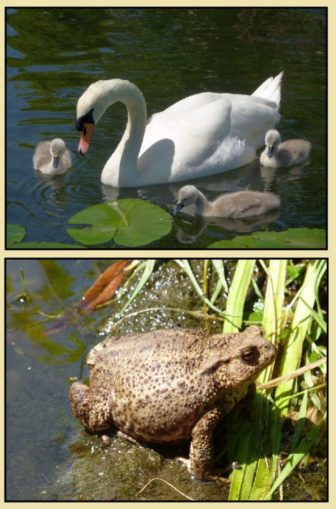
© SharpieType301 2018
Instead, we find a fabulous array of foraging along the bank. Luscious blackberries abound, the crab apples are fruiting and there are domestic apple trees here and there too. The elderberries are plumply purple (apparently roach like them too when they fall into the water), and there are more berries on the rowan trees than I’ve seen in years. Of course, we didn’t bring a bag so, as we can’t collect, we nibble as we meander along. Oddly, we don’t see any hazelnuts. A little early perhaps?
The other joy is the sheer number of fish we see. Mostly fry and small fish, and difficult to identify, but some larger shadows lurk in the deeper water. We are pretty sure there are pike (Esox lucius) here, as there are frequent flurries at the surface and sparkling splashes of silver as small fish try to evade something hunting them. And then we see one, just below the surface, camouflaged in the duckweed and other aquatic plants. This mighty predator is only a juvenile, a baby at possibly about 4” long, beautifully marked but yet to develop the characteristic yellowish spots on its sides. My husband tells me they should be referred to as ‘jack’ but to me they are, and always will be, pikelets!

© SharpieType301 2020
For us, this has been a fairly short walk, only about seven miles in total but age and arthritis are beginning to take their toll these days. A meander, more of an amble than a ramble, and all on the flat. But I can definitely recommend it if you find yourself in the area with a couple of hours to spare. Who knows, we might even bump into you there.
© SharpieType301 2020
The Goodnight Vienna Audio file



